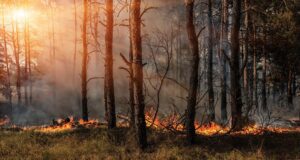January 2025 has brought devastating wildfires to the Los Angeles area with investigators racing to uncover their origins. The fires, driven by fierce winds, have ravaged thousands of homes, leaving communities in ruins. Early findings suggest that human activities, utility infrastructure, or equipment failures may be to blame, as lightning was absent during the outbreaks.

Human activities play a significant role in igniting these blazes. The deadly 2023 Maui fire, for example, began with a broken power line, while California’s largest fire in 2024 started when a burning car was pushed into a ravine near Chico, destroying over 700 structures. This year’s fires are yet another reminder of the devastating impact of human-related ignitions.
Wildfires thrive on three elements: conducive weather, dry fuel, and an ignition source. In recent decades, all three factors have intensified due to climate change, poor land management, and human encroachment into fire-prone regions.
Rising temperatures dry out vegetation, making it highly flammable. In the western U.S., aridity linked to climate change has doubled the forestland burned since 1984. The problem is exacerbated by increasing nighttime temperatures, which now rise faster than daytime temperatures, leaving fires to rage around the clock.
Winds also amplify fire behavior by spreading embers and intensifying combustion. High-speed gusts can turn a small blaze into a massive inferno, as has been evident in the recent LA fires.
Years of fire suppression have allowed dense vegetation to accumulate, creating a ready supply of fuel. Invasive grasses have worsened the problem by forming continuous fuel beds that accelerate fire spread. Human development in the wildland-urban interface where homes meet natural vegetation introduces additional flammable materials, compounding the risk.
Human Ignition
Humans are responsible for over 84% of wildfires affecting communities. Activities such as power line failures, sparks from machinery, or unattended campfires often occur under extreme weather conditions, making fires more severe. Unlike lightning-started fires, which are often accompanied by rain, human-ignited fires tend to erupt in dry, windy conditions, spreading rapidly before firefighters can respond.
Whiplash Weather Fuels Destruction
Southern California’s recent whiplash weather wet winters followed by scorching summer has exacerbated fire risks. A wet spring in 2024 spurred vegetation growth, which dried into combustible fuel during the summer heat. By January 2025, soil moisture levels in Los Angeles were at a record low, creating the perfect conditions for wildfires.
These wildfires not only devastate communities but also contribute to climate change. Fires release vast amounts of carbon dioxide, worsening global warming and creating a feedback loop that fuels even more severe fire seasons. As urban development expands into wildlands, the cycle of human-caused ignition and escalating wildfire risk continues.

A Call to Action
The January 2025 wildfires are a stark warning of the growing threats posed by climate change and human activities. To mitigate future disasters, efforts must focus on:
- Strengthening utility infrastructure to prevent equipment-related ignitions.
- Implementing controlled burns to reduce fuel buildup.
- Enhancing urban planning to minimize fire risks in vulnerable areas.
- Promoting public awareness of fire safety and prevention.
The flames consuming Los Angeles serve as a grim reminder that immediate action is essential to protect lives, property, and the environment from the ever-growing menace of wildfires.
